Table of Contents
- Configuring SWIRL AI Search
- Deploying SWIRL for Production Use
- Upgrading SWIRL
- Configuring SWIRL
- Search Expiration Service
- Search Subscriber Service
- Service Startup & Daemonization
- Disabling the Cookie Consent Notice in Galaxy
- Changing the Galaxy Logos and Branding
- Managing Django Users
- Management Tools
- Database Migration
- Configuring Django
- Configuring Celery & Redis
- Security
- SWIRL User & Group Support
Admin Guide
Community Edition | Enterprise Edition
Configuring SWIRL AI Search
Configuring the Environment
SWIRL uses django-environ to load critical settings from a file named .env.
- The
.env.distfile contains default settings. - If no
.envfile exists, theinstall.shscript copies.env.distto.env.
Example .env File:
SECRET_KEY=your-secret-key
ALLOWED_HOSTS=localhost
PROTOCOL=http
SWIRL_EXPLAIN=True
SQL_ENGINE=django.db.backends.sqlite3
SQL_DATABASE=db.sqlite3
SQL_USER=user
SQL_PASSWORD=password
SQL_HOST=localhost
SQL_PORT=5432
MICROSOFT_CLIENT_ID=''
MICROSOFT_CLIENT_SECRET=''
MICROSOFT_REDIRECT_URI=''
OPENAI_API_KEY=
Making Changes to .env
To configure hostname, protocol, or port:
- Edit the
.envfile. - Restart SWIRL for changes to take effect.
There should never be a .env file in the SWIRL repo. When upgrading SWIRL, these settings persist automatically.
Environment Variable Descriptions
SWIRL_EXPLAIN→ Enables the explain structure.SECRET_KEY→ A cryptographic salt used by Django. Generate a new one for production:
Creating a SWIRL Super User
To reset the database:
- Delete or rename the
db.sqlite3file. - Run:
python swirl.py setup
This creates a new blank database.
To create a Super User, run:
python manage.py createsuperuser --email admin@example.com --username admin
Changing the Super User Password
To change the password of an existing admin user:
python manage.py changepassword admin
If the new password is too simple, Django will reject it.
For more details, see: Django Admin and manage.py
Using the Django Admin
To change the Super User password via Django Admin:
- Go to: http://localhost:8000/swirl
-
Click "CHANGE PASSWORD":

-
Enter a new password:
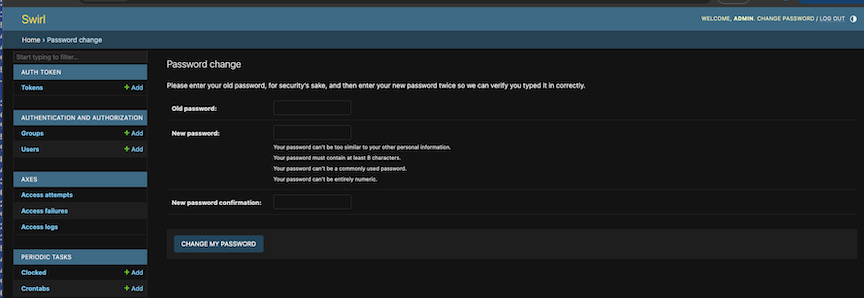
- Click "CHANGE MY PASSWORD".
Adding Normal Users
Users can be managed via Django Admin:
http://localhost:8000/admin/
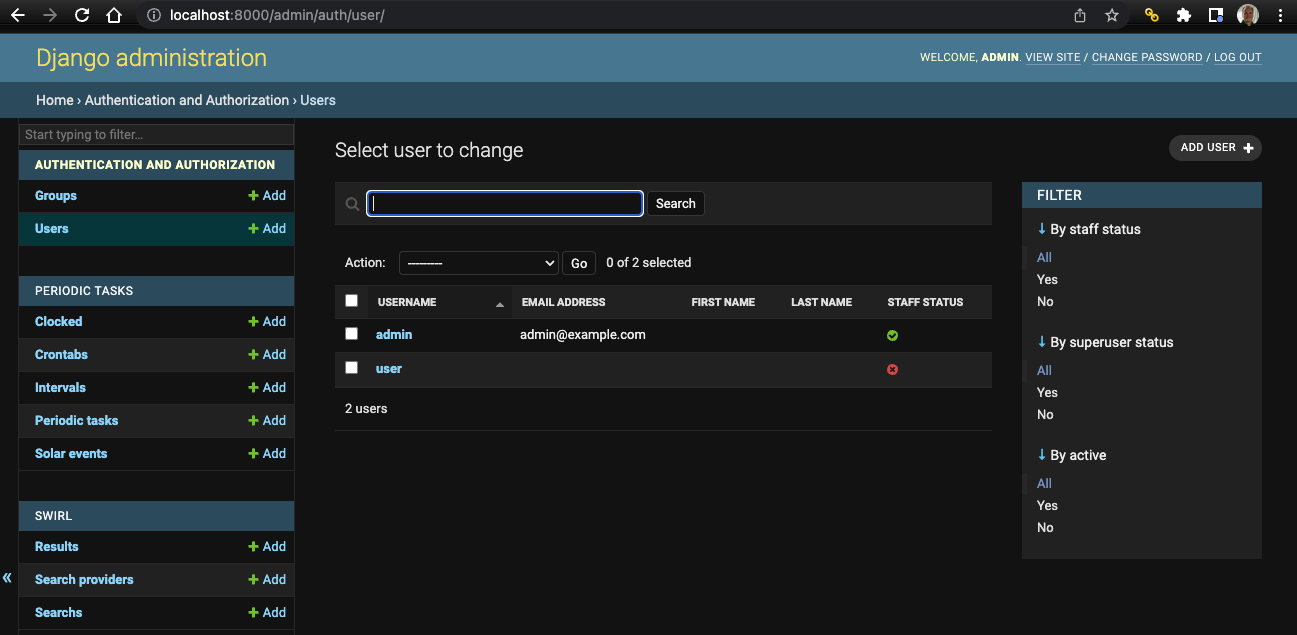
If using OpenID Connect, manual user creation is not required. See the AI Search Guide for details.
Permissioning Normal Users
Each SWIRL core object (SearchProviders, Search, Result, Query Transform) has four permissions:
add→ Allows creationchange→ Allows modificationdelete→ Allows removal-
view→ Allows read-only access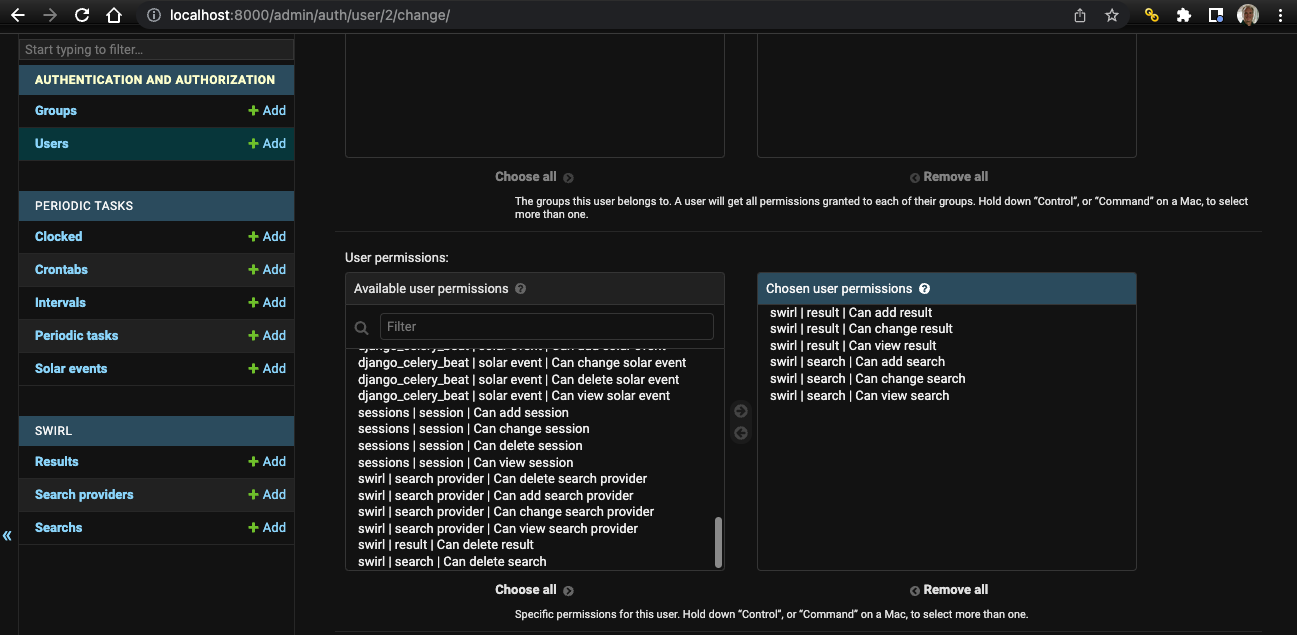
Recommended Permission Configurations
| Scenario | SearchProvider | Search | Results | Query Transform |
|---|---|---|---|---|
| Admin | ALL | ALL | ALL | ALL |
| Search ONLY | NONE | Add | ||
| Result ONLY | NONE | NONE | View | |
| Search & View Results | NONE | Add, View | Add, View | Add, View |
| Manage Search (including re-run) | NONE | ALL | ALL | ALL |
| SearchProvider Admin | ALL | Add | View | View |
Object Ownership
SearchProvider, Search, Result, and Query Transform objects are owned by the Django user who creates them and are private by default.
Shared SearchProviders and Query Transformations
- By default, sharing is disabled (
false) for all users. - Django Super Users (
admin) have sharing enabled (true) by default.
This prevents users from needing to duplicate SearchProviders or Query Transformations.
Managing Large User Groups
For installations with many users, consider:
- Creating user groups with predefined permissions.
- Assigning users to the appropriate groups.
This simplifies access control and reduces administrative overhead.
Deploying SWIRL for Production Use
The SWIRL application is designed to be deployed behind a reverse-proxy for optimal scalability, security, performance, and availability.
**Why Use a Reverse-Proxy?**
- Scalability:
- Enables horizontal scaling by distributing requests across multiple SWIRL servers.
- Dynamically provisions additional VMs when demand increases.
- Deactivates idle VMs to reduce hosting costs.
- Security:
- SSL/TLS termination at the reverse-proxy reduces CPU load on the application server.
- Performance:
- Separates static content delivery from the application server.
- Supports Content Delivery Networks (CDN) for faster response times.
- Availability:
- Load balances traffic across multiple backend SWIRL servers.
- Monitors and removes failed servers to maintain uptime.
**Recommended Reverse-Proxy Solutions**
For deployment assistance, please contact support.
Upgrading SWIRL
Local Installations
For Docker upgrades, please contact support for instructions!
- Update the
swirl-searchrepository:git pull - Run the install script:
./install.sh - Set up SWIRL:
python swirl.py setup - If upgrading the Galaxy UI, run:
./install-ui.sh -
Update AI prompts: ```shell python swirl.py reload_ai_prompts
-
Update Authenticators:
Check the release notes (see below) and update Authenticators that have changed.
```shell python manage.py load_authenticators swirl/fixtures/DefaultAuthenticators.json
-
Update SearchProviders:
Check the release notes (see below) and only update SPs that have changed.
python manage.py load_fixture SearchProviders/<searchprovider-name> - Restart SWIRL:
python swirl.py restart
Refer to the release notes for details on each update.
Docker
Refer to the appropriate guide for your edition:
Resetting Prompts
To reset AI prompts to the default settings, run:
python swirl.py reload_ai_prompts
This restores system prompts to factory settings while keeping custom prompts unchanged.
Resetting Authenticators
To update all Authenticators:
python manage.py load_authenticators swirl/fixtures/DefaultAuthenticators.json
Resetting SearchProviders
To reset a specific SearchProvider:
python manage.py load_fixture SearchProviders/<searchprovider-name>
Configuring SWIRL
SWIRL configuration is managed in: swirl_server/settings.py
Key Configuration Items
| Configuration Item | Explanation | Example |
|---|---|---|
| CELERY_BEATS_SCHEDULE | Defines the schedule for the Search Expiration Service and Search Subscriber Service | See linked sections |
| SWIRL_DEFAULT_QUERY_LANGUAGE | Determines the stopword dictionary | SWIRL_DEFAULT_QUERY_LANGUAGE = 'english' |
| SWIRL_TIMEOUT | Time (in seconds) before terminating slow connectors | SWIRL_TIMEOUT = 10 |
| SWIRL_SUBSCRIBE_WAIT | Timeout for updating a search | SWIRL_SUBSCRIBE_WAIT = 20 |
| SWIRL_DEDUPE_FIELD | Field used for duplicate detection | SWIRL_DEDUPE_FIELD = 'url' |
| SWIRL_DEDUPE_SIMILARITY_MINIMUM | Minimum similarity score to classify as duplicate | SWIRL_DEDUPE_SIMILARITY_MINIMUM = 0.95 |
| SWIRL_DEDUPE_SIMILARITY_FIELDS | Fields used for duplicate detection | SWIRL_DEDUPE_SIMILARITY_FIELDS = ['title', 'body'] |
| SWIRL_RELEVANCY_CONFIG | Defines relevancy score weights for key fields | See below |
| SWIRL_MAX_MATCHES | Maximum matches per result (limits long articles) | SWIRL_MAX_MATCHES = 5 |
| SWIRL_MIN_SIMILARITY | Minimum score required for query hits to be scored | SWIRL_MIN_SIMILARITY = 0.54 |
| SWIRL_EXPLAIN | Enables relevancy explain structures in responses | SWIRL_EXPLAIN = false |
Example SWIRL_RELEVANCY_CONFIG
SWIRL_RELEVANCY_CONFIG = {
'title': {
'weight': 1.5
},
'body': {
'weight': 1.0
},
'author': {
'weight': 1.0
}
}
All configuration items must be uppercase, following the Django settings convention.
Search Expiration Service
The Expirer service automatically deletes expired Search objects and their associated Result objects. This prevents SWIRL from retaining all past searches indefinitely.
Service Frequency
SWIRL allows custom expiration settings for Search and Result objects, but the expiration service runs on a fixed schedule.
- By default, it runs every hour.
- The schedule is defined in the Django settings:
CELERY_BEAT_SCHEDULE = {
# Executes every hour
'expire': {
'task': 'expirer',
'schedule': crontab(minute=0, hour='*'),
},
}
-
Temporary changes can be made via the Django Admin Console:
http://localhost:8000/admin/django_celery_beat/crontabschedule/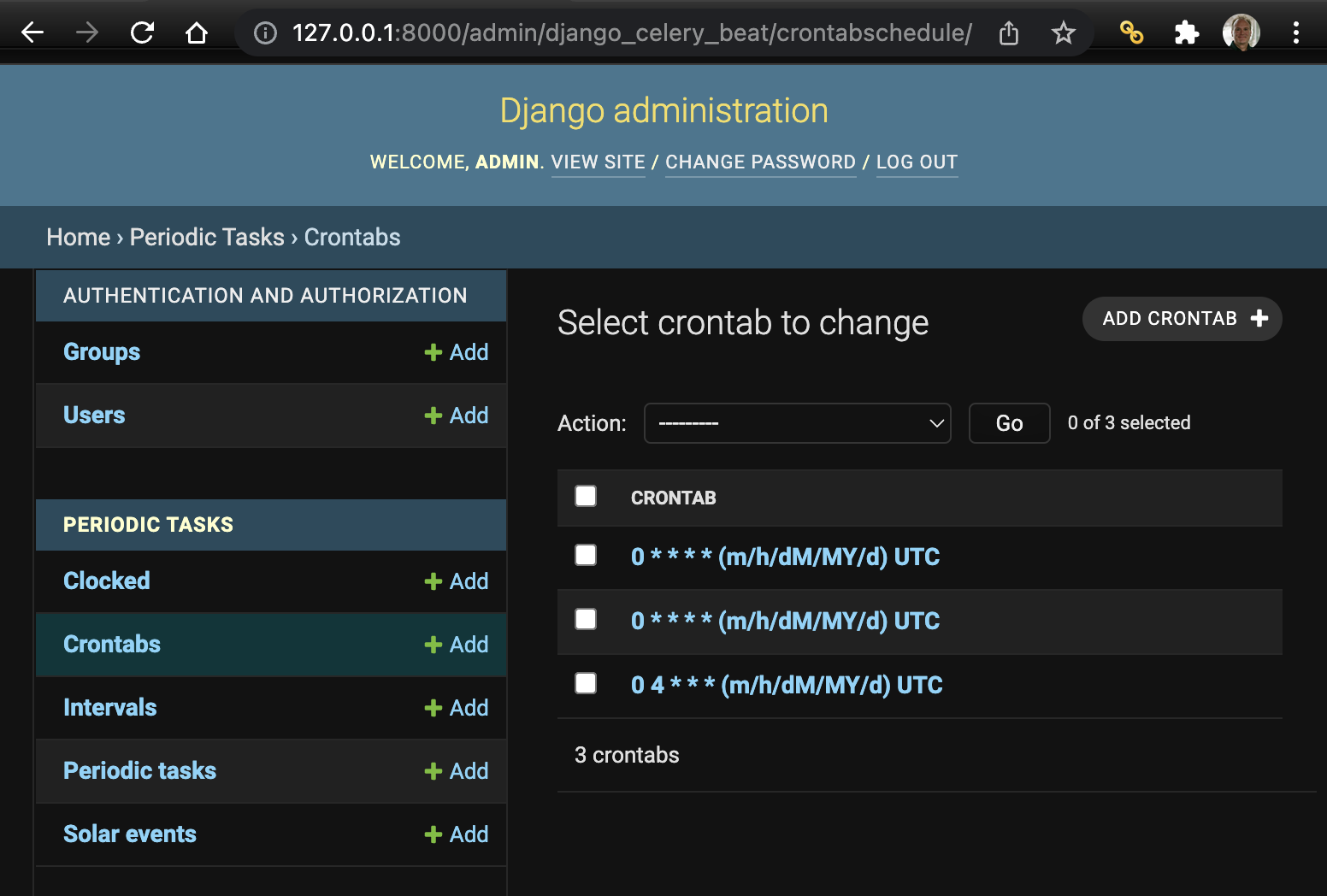
Enterprise Edition supports a 5-minute expiration schedule. Please contact support for details.
If you modify crontab in the database without updating CELERY_BEAT_SCHEDULE, the original schedule will be restored when SWIRL restarts.
Search Subscriber Service
When a Search object has subscribe=True, SWIRL will periodically update that Search. See the Developer Guide for more details.
- By default, the service runs every 4 hours.
- The schedule is defined in Django settings:
CELERY_BEAT_SCHEDULE = {
# Executes every four hours
'subscribe': {
'task': 'subscriber',
'schedule': crontab(minute=0, hour='*/4'),
},
}
-
Temporary changes can be made via the Django Admin Console:
http://localhost:8000/admin/django_celery_beat/crontabschedule/
If you modify crontab in the database without updating CELERY_BEAT_SCHEDULE, the original schedule will be restored when SWIRL restarts.
Service Startup & Daemonization
Using swirl.py
For normal operations, use swirl.py to start, stop, or restart services. This script is located in the SWIRL installation directory (next to manage.py).
**Starting Services**
python swirl.py start
To start specific services, specify them by name:
python swirl.py start celery-beats
**Checking Service Status**
python swirl.py status
Example output:
INFO 2025-03-01 19:59:55 settings Swirl Enterprise 4.1-DEV licensed to: SWIRL_Corporation
. o
. . . o
. .
o . @ @ . SWIRL AI ENTERPRISE 4.1-DEV
. @ @ . . Licensed to: SWIRL_Corporation
. . . . . .
. . o
o . o .
Service: django...RUNNING, pid:34738
Service: celery-worker...RUNNING, pid:34767
PID TTY TIME CMD
34738 ttys005 0:56.97 /Library/Frameworks/Python.framework/Versions/3.12/Resources/Python.app/Contents/MacOS/Python /Library/Frameworks/Python.framework/Versions/3.12/bin/daphne -b 0.0.0.0 -p 8000 swirl_server.asgi:application
34767 ttys005 2:10.94 /Library/Frameworks/Python.framework/Versions/3.12/Resources/Python.app/Contents/MacOS/Python /Library/Frameworks/Python.framework/Versions/3.12/bin/celery -A swirl_server worker -Q default --without-heartbeat --without-gossip --without-mingle --loglevel=info --concurrency=15
Command successful!
**Stopping Services**
python swirl.py stop
**Restarting Services**
python swirl.py restart
To restart specific services, specify them by name:
python swirl.py restart celery-worker consumer
**Getting Help**
python swirl.py help
Customizing
The services invoked by swirl.py are defined in: swirl/services.py
Modify this list to automatically start celery-beats.
Disabling the Cookie Consent Notice in Galaxy
By default, the Cookie Consent Notice will appear for users in Galaxy until they accept it.

To prevent the notice from appearing, add the following to the .env file:
COOKIE_CONSENT_DISPLAY=False
Changing the Galaxy Logos and Branding
To customize the logo, search button, and labels in SWIRL Galaxy:
-
Go to the SWIRL Admin Page: http://localhost:8000/admin/

-
Click the "admin" link to open the Admin UI:

-
Click "Upload a Branding Configuration" to go to the Branding Configuration page:
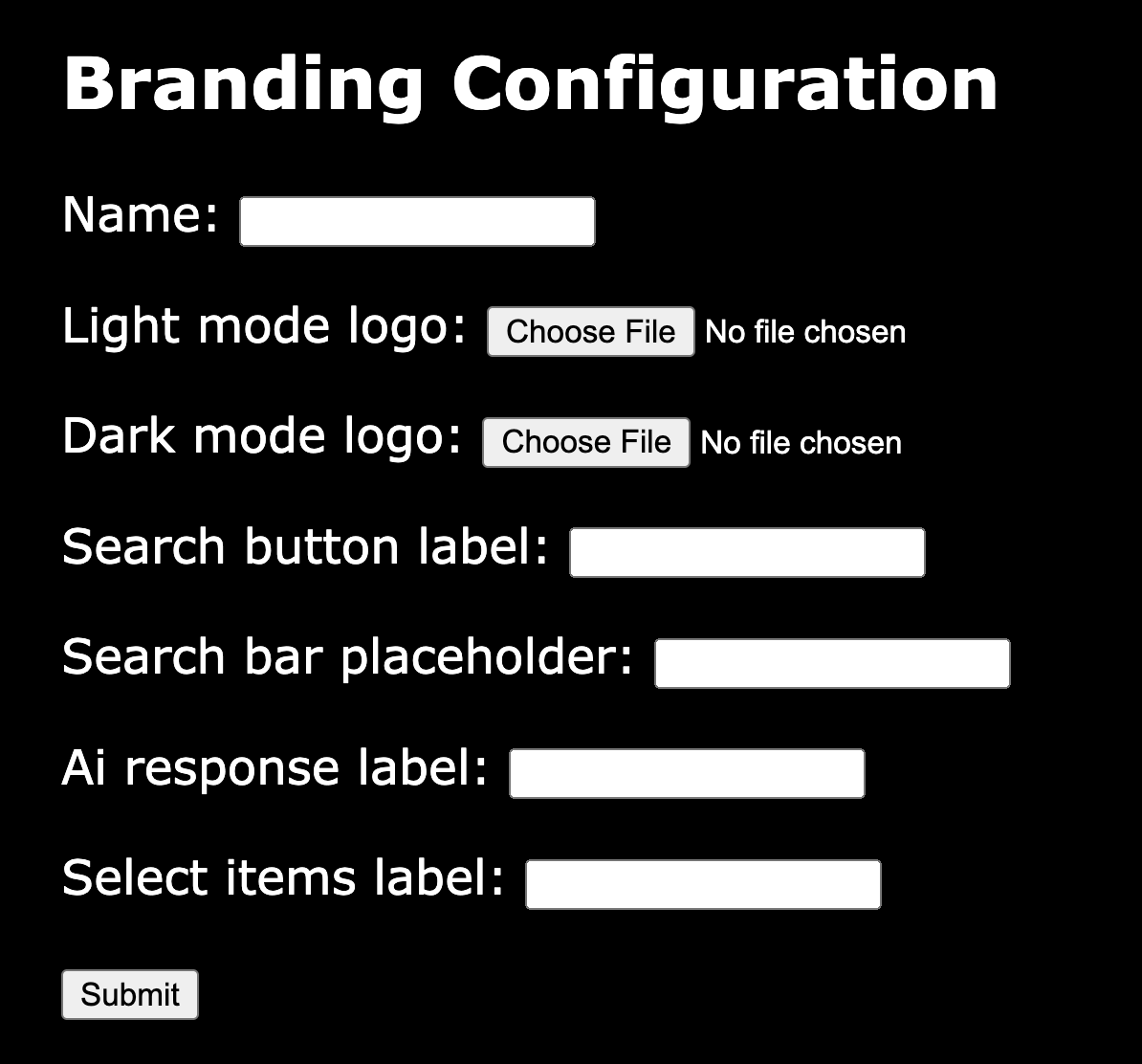
-
Fill out the form:
- "Name" is required.
- At least one additional field must be customized.
- To change the logo, upload a light mode image.
Branding Configuration Options
| Item | Galaxy Location | Default |
|---|---|---|
| Name | Not shown | N/A |
| Search button label | Search button text | SEARCH |
| Search bar placeholder | Placeholder text in search box | "What are you searching for today?" |
| AI Response label | Below search box | "Generate AI Response" |
| Select items label | Below paging control | "Select Items" |
- Click "Submit" to save your branding changes.
- Refresh your browser to apply changes in Galaxy UI.
Refreshing may start a new RAG or chat session.
Logo File Suggestions
- Format: PNG
- Dimensions: 818 × 214 px
- Whitespace: At least 30 px margin around the logo
Only one branding configuration can be active at a time.
Restoring a Previous Branding Configuration
SWIRL displays the last updated branding configuration. To make a previous configuration active:
-
Go to the SWIRL Admin Page: http://localhost:8000/admin/
-
Scroll down to Branding Configurations under the SWIRL section. Click it.
-
Click on a previous configuration. Then click SAVE at the bottom of the form. No actual changes need to be made.
Reload Galaxy in the browser. The saved branding configuration will appear, replacing the previous one.
Managing Django Users
Django Admin
Most users can be managed through Django Admin, accessible at:
http://localhost:8000/admin/
For more details, watch this YouTube video on Django Administration.
Changing a User's Password
To change a user's password via the command line:
python manage.py changepassword <user_name>
Unlocking a Locked Account
-
Login to the SWIRL UI with a different superuser account.
-
Open the user profile icon in the top right corner, and click the
Manage SWIRLlink: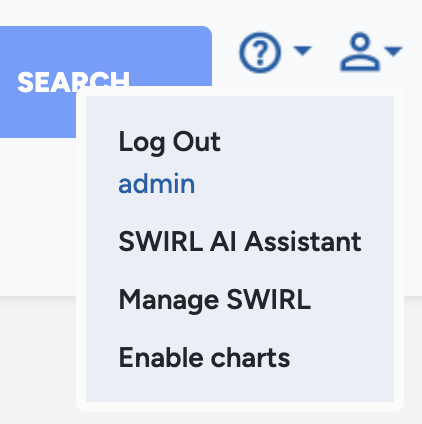
-
From the new tab that opens, click the
Adminlink to enter the Django Admin area. -
In the top left corner, click on the “Reset Lockout Attempts for User” option:
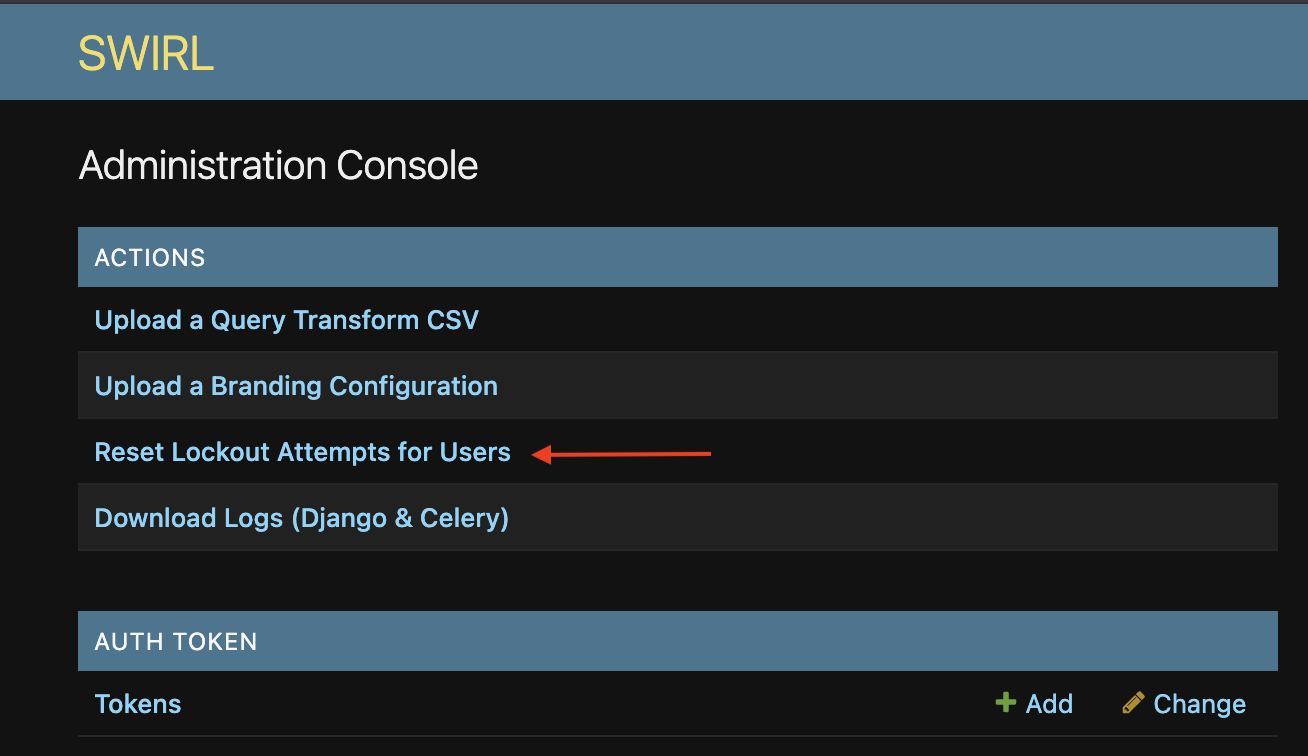
-
In the new tab that opens, select the “admin” user from the list of locked out accounts. (In the example above, we are unlocking the user
testuser01.) With the user selected, click theResetbutton on this page: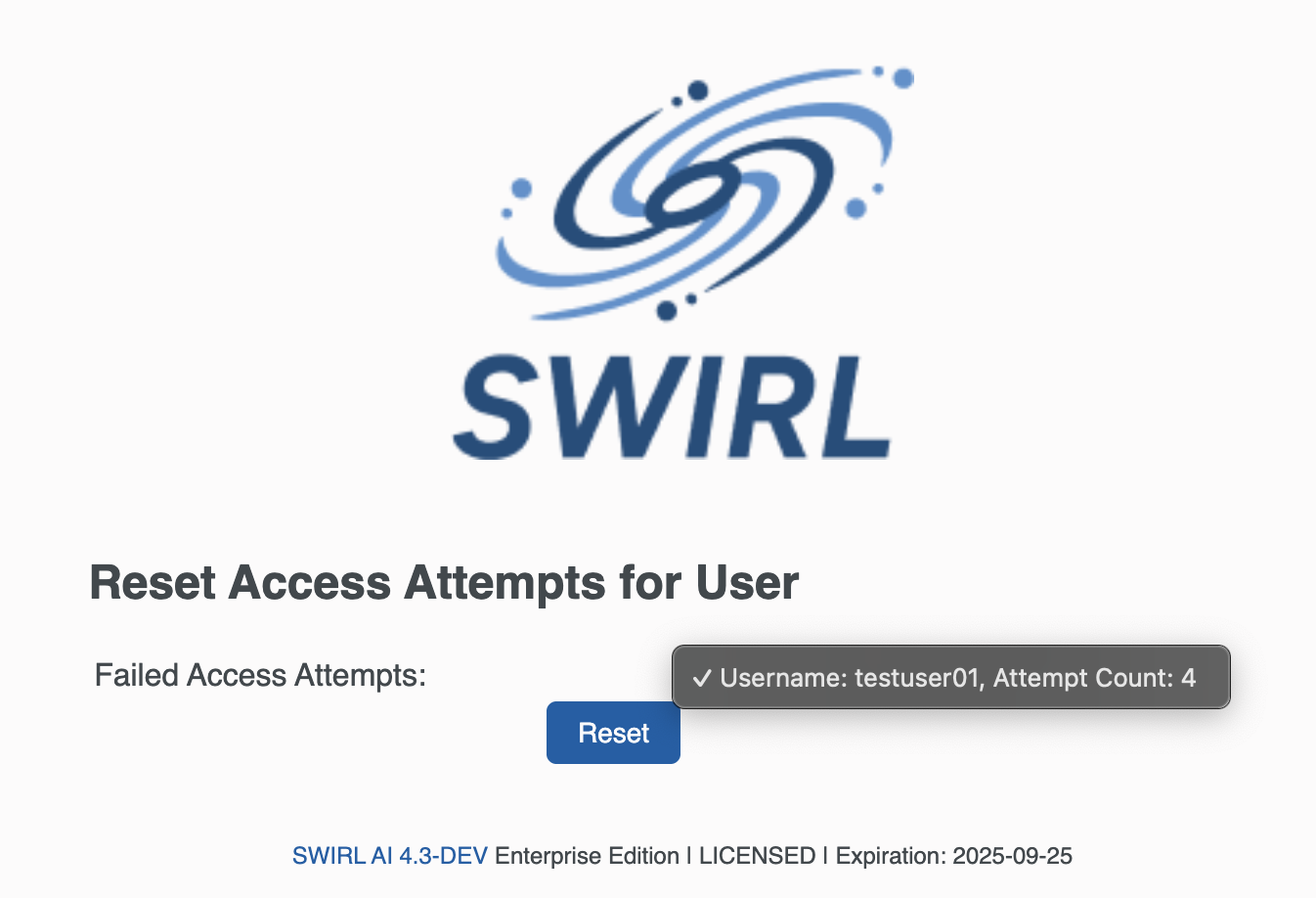
-
Return to main SWIRL UI tab, and select the User Profile icon again. Click
Logoutfor the superuser account. -
This returns you to the SWIRL login page where you should be able to login again with the
adminuser, now unlocked!
Management Tools
Django Console
Django provides a web-based UI for managing users, groups, crontabs, and more.
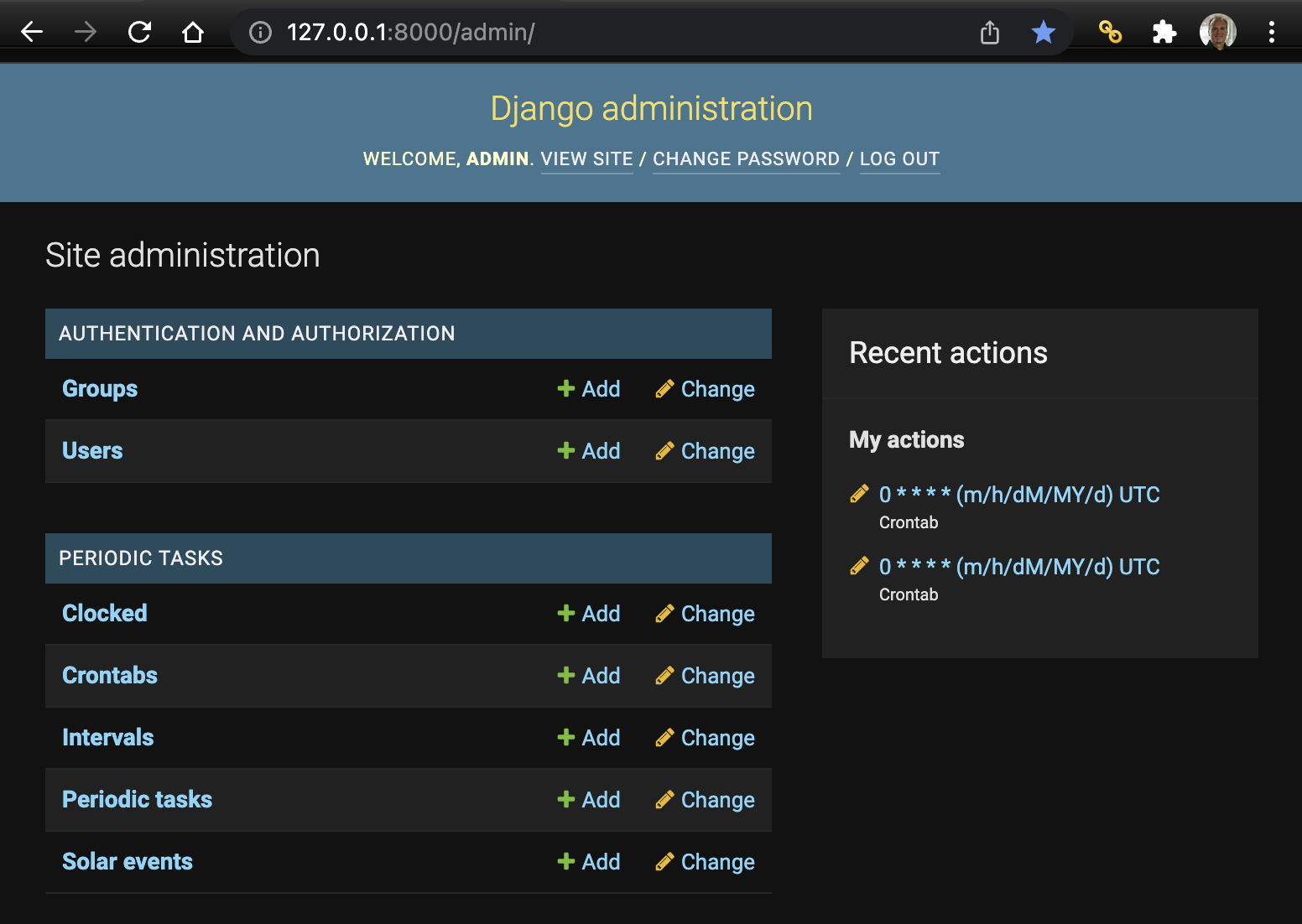
Access it here: http://localhost:8000/admin/
For an in-depth tutorial, watch this YouTube playlist on Django Admin.
Django dbshell
Django has a built-in shell for direct database management. Run it inside the swirl-search directory:
./manage.py dbshell
Wiping the Database
To delete all SWIRL objects and reset the database:
python manage.py flush
This will remove all data permanently.
You must create a new SWIRL Super User after doing this.
sqlite-web
sqlite-web provides an open-source web-based GUI for SQLite.
**Installation & Usage**
pip install sqlite-web
sqlite_web my_database.db # Runs locally at http://localhost:8080/
sqlite_web --host 0.0.0.0 my_database.db # Run it on the LAN
Use the full path to db.sqlite3 in swirl-search when running sqlite-web.
Database Migration
If you modify swirl/models.py, you must run a database migration.
**Basic Migration Command**
python swirl.py migrate
For more details, see: https://docs.djangoproject.com/en/4.0/topics/migrations/
**General Migration Guidelines**
- Adding fields or changing defaults is usually simple.
- If renaming an
idor modifying relationships, consider wiping existing data first (sqlite-webcan help).
**If Migration Fails**
- Delete
db.sqlite3 - Delete all files in
swirl/migrations/ - Run:
python manage.py flush - Repeat the migration process.
After flushing the database, don't forget to create a SWIRL Super User.
Configuring Django
SWIRL's Django configuration is managed in:
swirl_server/settings.py
Key Configuration Items
Hostname & Protocol
# Set the Fully Qualified Domain Name (FQDN) first
ALLOWED_HOSTS = ['localhost']
HOSTNAME = ALLOWED_HOSTS[0]
PROTOCOL = 'http'
The FQDN SWIRL should listen on must be the first entry in ALLOWED_HOSTS.
Time Zone
TIME_ZONE = 'US/Eastern'
CELERY_TIMEZONE = "US/Eastern"
CELERY_TIME_ZONE = "US/Eastern"
Celery Beats
Celery-Beats is used for scheduled services like the Search Expiration Service and the Search Subscription Service.
CELERY_BEAT_SCHEDULE = {
# Executes every hour
'expire': {
'task': 'expirer',
'schedule': crontab(minute=0, hour='*'),
},
}
Database Provider
DATABASES = {
"default": {
"ENGINE": os.environ.get("SQL_ENGINE", "django.db.backends.sqlite3"),
"NAME": os.environ.get("SQL_DATABASE", BASE_DIR / "db.sqlite3"),
"USER": os.environ.get("SQL_USER", "user"),
"PASSWORD": os.environ.get("SQL_PASSWORD", "password"),
"HOST": os.environ.get("SQL_HOST", "localhost"),
"PORT": os.environ.get("SQL_PORT", "5432"),
}
}
The following sections apply only to SWIRL Community Edition. For Enterprise Edition instructions view the AI Connect Guide.
Configuring PostgreSQL as the Database Backend
- Install PostgreSQL (if not already installed).
- Ensure
pg_configis in yourPATHand runs from the command line. - Install the PostgreSQL driver:
pip install psycopg2
- If you are usingUncomment the PostgreSQL connector** in these files:
swirl/connectors/__init__.py
# Uncomment this line to enable PostgreSQL
# from swirl.connectors.postgresql import PostgreSQL
swirl/models.py
CONNECTOR_CHOICES = [
...
# Uncomment the line below to enable PostgreSQL
# ('PostgreSQL', 'PostgreSQL'),
...
]
For further setup, follow the Django Database Configuration Guide.
Configuring Celery & Redis
SWIRL uses Celery for executing metasearch requests asynchronously, with Redis as the backend.
Celery is configured in at least three locations. They must be consistent!
1. swirl_server/celery.py
app = Celery('swirl_server',
broker='redis://localhost:6379/0',
backend='redis://localhost:6379/0')
To verify the setup, run Celery from the command line:
> transport: amqp://guest:**@localhost:6379//
- ** ---------- .> results: rpc://
2. swirl_server/settings.py (Django Settings)
# Celery Configuration Options
CELERY_TIMEZONE = 'US/Eastern'
CELERY_TASK_TRACK_STARTED = True
CELERY_TASK_TIME_LIMIT = 30 * 60
CELERY_BEAT_SCHEDULE = {
'expire': {
'task': 'expirer',
'schedule': crontab(minute=0, hour='*'),
},
'subscribe': {
'task': 'subscriber',
'schedule': crontab(minute=0, hour='*/4'),
},
}
CELERY_BROKER_URL = 'redis://localhost:6379/0'
CELERY_RESULT_BACKEND = 'redis://localhost:6379/0'
Security
The Django Secret Key
Django's SECRET_KEY is a cryptographic salt used for security. If changed, active users will need to log in again.
To generate a new secret key:
python -c "import secrets; print(secrets.token_urlsafe())"
For more details: Django Secret Key Guide.
SWIRL User & Group Support
Django provides built-in authentication with User and Group objects. These can be managed via the Django Console or API.
User Management API
| URL | Explanation |
|---|---|
/swirl/users/ | List User objects & create new users |
/swirl/users/id/ | Retrieve, delete, or edit a User object |
Group Management API
| URL | Explanation |
|---|---|
/swirl/groups/ | List Group objects & create new groups |
/swirl/groups/id/ | Retrieve, delete, or edit a Group object |
Alternatively, use the Django Console: 
For additional details, see User Authentication in Django.